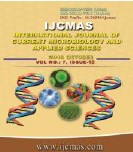


 National Academy of Agricultural Sciences (NAAS)
National Academy of Agricultural Sciences (NAAS)

|
PRINT ISSN : 2319-7692
Online ISSN : 2319-7706 Issues : 12 per year Publisher : Excellent Publishers Email : editorijcmas@gmail.com / submit@ijcmas.com Editor-in-chief: Dr.M.Prakash Index Copernicus ICV 2018: 95.39 NAAS RATING 2020: 5.38 |
The chickpea genotype ICCV 5530, which is moderately resistant and ICCV 4991, susceptible to Ascochyta rabiei were selected to identify the changes in biochemical activity in response to infection by the fungus Ascochyta rabiei. Twelve day old seedlings were inoculated with spore suspension of the pathogen at 5 × 104 spore/ml concentration using a Haemocytometer and incubated under Controlled Environmental Facility (CEF). Sampling was done at 2, 4 and 8 days after inoculation. Chlorophyll ‘a’, chlorophyll ‘b’ and total chlorophyll, total phenol, total soluble sugars, Peroxidase (PO), Polyphenol Oxidase (PPO) Phenylalanine Ammonia Lyase (PAL) activity was assayed by adopting the standard procedure described by various researchers. Higher total chlorophyll content was recorded in un-inoculated leaves of ICCV 4991 and ICCV 5530 genotypes compared to inoculated leaves. But higher total chlorophyll content was recorded in ICCV 5530 than susceptible at all the stages of sampling. The inoculated genotype ICCV 5530 had higher total phenolic content (11.57 mg/g fresh wt) than the ICCV 4991(7.32 mg/g fresh wt). The low concentration of total phenolics in leaves of ICCV 4991 genotype might be the reason for becoming highly susceptible to the disease. Lesser accumulation of the total soluble sugar was observed in ICCV 5530(7.95 mg/g fresh wt.) as compared to ICCV 4991(13.08 mg/h fresh wt). However, the expression level of defense related enzymes like PO, PPO and PAL were differed largely in moderately resistant and susceptible genotypes after infection with the pathogen. The increased activity of phenolic compounds, total sugars, CAT, PO, PPO and PAL were found in moderately resistant genotype compared to susceptible one. Therefore, these factors might be involved imparting disease resistance and could be considered for development of broad based resistance against ascochyta blight.
 |
 |
 |
 |
 |